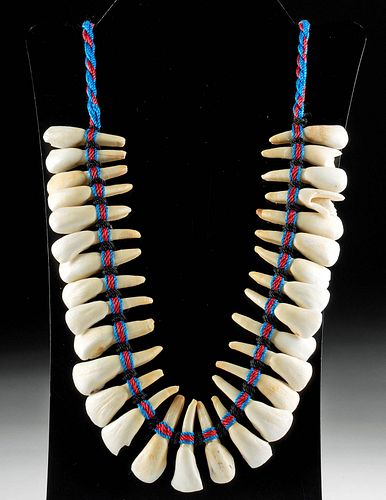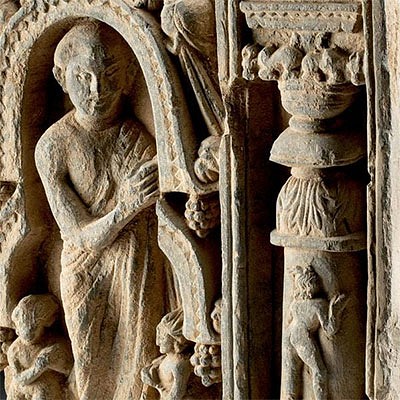20th C. Native American Cord Necklace w/ Buffalo Teeth
Lot 256
About Seller
Artemis Fine Arts
686 S Taylor Ave, Ste 106
Louisville, CO 80027
United States
Selling antiquities, ancient and ethnographic art online since 1993, Artemis Gallery specializes in Classical Antiquities (Egyptian, Greek, Roman, Near Eastern), Asian, Pre-Columbian, African / Tribal / Oceanographic art. Our extensive inventory includes pottery, stone, metal, wood, glass and textil...Read more
Categories
Estimate:
$400 - $600
Absentee vs Live bid
Two ways to bid:
- Leave a max absentee bid and the platform will bid on your behalf up to your maximum bid during the live auction.
- Bid live during the auction and your bids will be submitted real-time to the auctioneer.
Bid Increments
| Price | Bid Increment |
|---|---|
| $0 | $25 |
| $300 | $50 |
| $1,000 | $100 |
| $2,000 | $250 |
| $5,000 | $500 |
| $10,000 | $1,000 |
| $20,000 | $2,500 |
| $50,000 | $5,000 |
| $100,000 | $10,000 |
| $200,000 | $20,000 |
About Auction
By Artemis Fine Arts
Sep 16, 2021
Set Reminder
2021-09-16 10:00:00
2021-09-16 10:00:00
America/New_York
Bidsquare
Bidsquare : Ancient & Ethnographic Art Through The Ages
https://www.bidsquare.com/auctions/artemis-gallery/ancient-ethnographic-art-through-the-ages-7473
Ancient art from Egypt, Greece, Italy and the Near East, as well as Asian, Fossils, Pre-Columbian, Native American, African / Tribal / Oceanic, Fine art, and much more! All categories, all price ranges... all legally acquired and guaranteed to be as described or your money back. Artemis Fine Arts info@artemisfinearts.com
Ancient art from Egypt, Greece, Italy and the Near East, as well as Asian, Fossils, Pre-Columbian, Native American, African / Tribal / Oceanic, Fine art, and much more! All categories, all price ranges... all legally acquired and guaranteed to be as described or your money back. Artemis Fine Arts info@artemisfinearts.com
- Lot Description
Native American, Western United States, Plains Tribes, ca. 20th century CE. An interesting necklace made from woven nylon cords and 30 bison (buffalo) teeth. The cords are red, blue, and black strands that are twisted and woven to secure the teeth in place. A dab of adhesive is added to each tooth to ensure it stays in place. The length can be knotted at the neck to wear or display. Bison were an invaluable animal for many tribes and were used for food, medicine, tools, and clothing. These majestic animals embody the "Old West" and are integral to many traditional ways of life and religious beliefs. Size of strand: 36" L (91.4 cm); teeth: 2" L x 0.6" W (5.1 cm x 1.5 cm)
Bison, often known as the American buffalo, are in the bovine family, which contains Taurids (cattle) and bisonids, diverged from a common ancestor with the water buffalo and African buffalo around 5 to 10 million years ago. The bison at some point migrated from the Old World into the New. During the Ice Age, they were much larger, with species like Bison latifrons (giant bison) and Bison antiquus evolving to become smaller and smaller as the millennia passed and the climate changed. That does not mean they are small animals in our non-Ice Age times - in fact, today, they are the largest land mammal in North America - bigger than moose, elk, and even grizzly bears! Adult males can weigh up to 2000 pounds and stand six feet tall.
The European settlers hunted bison nearly to extinction in the 19th century. The Flathead Indian Reservation was home to a free ranging herd that was protected by the Confederated Salish and Kootenai tribes (CSKT), to save the animals from being completely decimated. This necklace may be made from the teeth of this herd or their descendants. In 1908 the American government seized the land and herd from the CSKT and established the National Bison Range, taking the control and management of the herd away from the tribes. As of 2019, the herd's management has finally been transferred back to CSKT.
Provenance: private Fayetteville, Arkansas, USA collection; ex-Dr. David Harner collection, Springdale, Arkansas, USA, acquired between the 1950s and 1960s
All items legal to buy/sell under U.S. Statute covering cultural patrimony Code 2600, CHAPTER 14, and are guaranteed to be as described or your money back.
A Certificate of Authenticity will accompany all winning bids.
PLEASE NOTE: Due to recent increases of shipments being seized by Australian & German customs (even for items with pre-UNESCO provenance), we will no longer ship most antiquities and ancient Chinese art to Australia & Germany. For categories of items that are acceptable to ship to Australia or Germany, please contact us directly or work with your local customs brokerage firm.
Display stands not described as included/custom in the item description are for photography purposes only and will not be included with the item upon shipping.
#167256Chips to the crowns of teeth, and larger losses to 2 teeth. Stable fissures and striations. Nylon cord is intact and very good. Wearable as shown.Condition
- Shipping Info
-
All shipping is handled in-house for your convenience. Your invoice from Artemis Gallery will include shipping calculation instructions. If in doubt, please inquire BEFORE bidding for estimated shipping costs for individual items.
-
- Buyer's Premium



 EUR
EUR CAD
CAD AUD
AUD GBP
GBP MXN
MXN HKD
HKD CNY
CNY MYR
MYR SEK
SEK SGD
SGD CHF
CHF THB
THB













